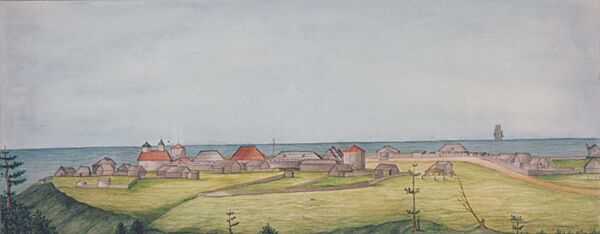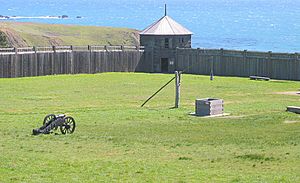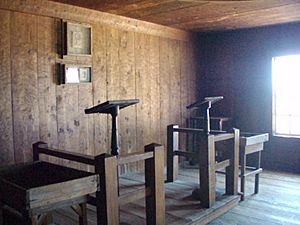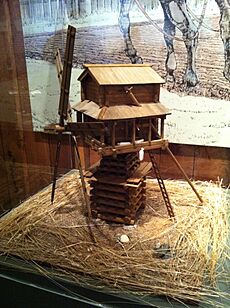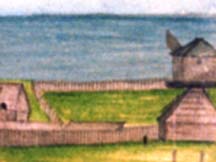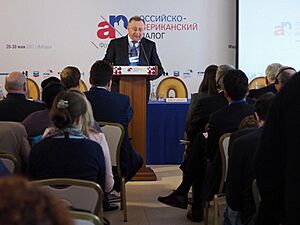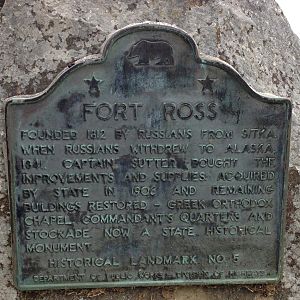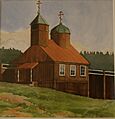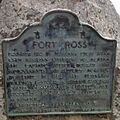Fort Ross, California facts for kids
|
Fort Ross
|
|
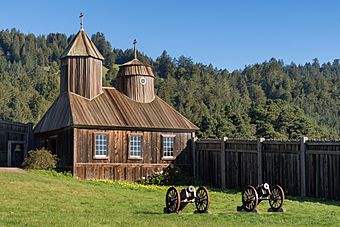
Orthodox Holy Trinity St. Nicholas Chapel at Fort Ross, 2016
|
|
| Location | Fort Ross State Historic Park, Sonoma County, California |
|---|---|
| Nearest city | Healdsburg, California |
| Built | 1812 |
| NRHP reference No. | 66000239 |
Quick facts for kids Significant dates |
|
| Added to NRHP | October 15, 1966 |
| Designated NHL | November 5, 1961 |
Fort Ross was a Russian settlement on the west coast of North America. It is located in what is now Sonoma County, California. From 1812 to 1841, it was the main center for the southernmost Russian settlements in North America.
Fort Ross was special because it was the first place in northern California where many different groups lived together. These included Native Californians, Native Alaskans, Russians, Finns, and Swedes. Today, it is a California Historical Landmark and a National Historic Landmark. It is also part of Fort Ross State Historic Park.
Contents
- What Does Fort Ross Mean?
- A Look Back at Fort Ross's History
- Fort Ross Cemetery: A Place of Rest
- Windmills at Fort Ross: Early Technology
- The Fort Ross Archaeological Project
- Leaders of Fort Ross
- Places Named After Fort Ross
- Important Dates in Fort Ross History
- Fort Ross Dialogue: US-Russian Relations
- Buildings at Fort Ross
- Fort Ross: A California State Landmark
- Climate at Fort Ross
- Images for kids
- See also
What Does Fort Ross Mean?
The name Fort Ross first appeared on a French map in 1842. The word "Ross" comes from the Russian word rus or ros. This is the same root word as "Russia" (Pоссия, Rossiya).
Some say "Ross" is a poetic Russian name for a Russian person. The original name was Fortress Ross.
A Look Back at Fort Ross's History
In the early 1800s, two big powers met on the coast of California. Spain had moved west across the Atlantic Ocean. Russia had moved east across Siberia and the Pacific.
At this time, British and American fur trading companies were also in the area. Mexico would soon become independent from Spain. The story of Fort Ross began when California was under Spanish rule. It ended when California was under Mexican rule.
The First People of Fort Ross
The first people known to live at the Fort Ross site were there a very long time ago. This was between 1000 B.C. and A.D. 500. The main time people lived there started around A.D. 1500 and continued until 1812.
Native Californians lived in large, mostly permanent villages. In summer, they used "special purpose camps" to gather resources. The Fort Ross area was one of these camps. It was good for getting food from the ocean.
The Kashaya Pomo people lived in this area. Their name for the site was "Metini". They likely moved to Metini between 1,000 and 500 B.C. They used many different tools and gathered more food after moving here.
The Russian-American Company Arrives
Russian explorers from Alaska first came to California on American ships. In 1803, American ship captains suggested hunting sea otters together. They would use Russian leaders and Native Alaskan hunters.
These hunting trips showed the Russians that parts of the California coast were empty. Alexander Andreyevich Baranov, who led the Russian-American Company (RAC), thought about building a settlement. This settlement would be north of where the Spanish were in San Francisco.
In 1806, a Russian ambassador named Nikolay Rezanov visited California. He wanted to set up a way to get food for the Russian colonies. His captain explored the coast north of San Francisco Bay. They found it was not settled by other European countries. Rezanov told Baranov that a settlement should be built in California.
This settlement [Ross] has been organized through the initiative of the Company. Its purpose is to establish a [Russian] settlement there or in some other place not occupied by Europeans, and to introduce agriculture there by planting hemp, flax and all manner of garden produce; they also wish to introduce livestock breeding in the outlying areas, both horses and cattle, hoping that the favorable climate, which is almost identical to the rest of California, and the friendly reception on the part of the indigenous people, will assist in its success.
Ivan Kuskov of the Russian-American Company started Fort Ross. In 1808, Baranov sent two ships to find places for settlements. Kuskov was told to claim land at Trinidad, Bodega Bay, and north of San Francisco.
In 1809, Kuskov sailed into Bodega Bay. He returned to Alaska with many beaver and otter furs. Baranov then told Kuskov to go back and build a farming settlement.
After a try in 1811, Kuskov returned to Bodega Bay in March 1812. He named it the Gulf of Rumyantsev. He also named the Russian River the Slavic River. Kuskov found that otters were now rare in Bodega Bay.
They chose a spot about 15 miles (24 km) north. The native Kashaya Pomo people called this place Metini. Metini was a seasonal home for the Kashaya Pomo. It had a good place for ships and lots of natural resources. This became the Russian settlement of Fortress Ross.
Fort Ross was meant to be a farm base to supply food to the Russian settlements in Alaska. It also continued trade with California. However, for its first ten years, the fort cost a lot of money to keep running.
Fort Ross was the main center for several smaller Russian settlements. These were called "Fortress Ross" on official maps. "Colony Ross" meant the whole area where Russians had settled. These settlements were the southernmost Russian colony in North America. They stretched from Point Arena to Tomales Bay.
The colony had a port at Bodega Bay, called Port Rumyantsev. There was also a sealing station on the Farallon Islands. By 1830, there were three small farming communities called "ranchos": Chernykh, Khlebnikov, and Kostromitinov.
Life and Work at Fort Ross
Besides farming and making things, the Russian-American Company also traded furs at Fort Ross. But by 1817, after many years of hunting by different countries, sea otters were almost gone from the area.
Fort Ross was home to California's first windmills and shipbuilding. Russian scientists who lived there were among the first to write about California's history and nature. The Russian leaders brought new ideas like glass windows, stoves, and all-wood houses to California.
People from many different backgrounds lived at Fort Ross. These included Russian subjects (like Russians, Ukrainians, Finns), North Pacific Natives, Aleuts, Kashaya (Pomo), and Alaskan Creoles.
Diseases like smallpox and measles affected the native people in the Sonoma and Napa County regions. These diseases were common in other parts of the world. The first vaccination in California happened in 1821. A Russian ship brought vaccine to Monterey. In 1837, a very serious smallpox outbreak came from Fort Ross. It caused many native people in the Sonoma and Napa County areas to die.
Why Fort Ross Declined
By 1839, Fort Ross was not as important for farming. The fur-bearing marine mammals were almost gone from too much hunting. Also, the California missions, which used to help with food, were no longer doing so.
In 1838, the Russian-American Company made a deal with the Hudson's Bay Company. This deal meant the Alaskan colonies would get their food from other places. So, Fort Ross was no longer needed to supply food.
The Russian-American Company then tried to sell the settlement. In 1841, it was sold to John Sutter. He was a Mexican citizen from Switzerland. Sutter later became famous for finding gold at his lumber mill.
Fort Ross in the 20th Century
After John Sutter, Fort Ross was owned by different private people. Finally, George W. Call owned it. In 1903, the stockade (the fence around the fort) and about 3 acres (1.2 ha) of land were bought by the California Historical Landmarks Commission.
Three years later, it was given to the State of California. The state wanted to protect and restore it as a historic monument. Since then, the state has bought more land around the fort for preservation. The California Department of Parks and Recreation and many volunteers work hard to restore and rebuild parts of the Fort.
At one time, CA 1 went right through Fort Ross. It entered where the Kuskov House used to be and left through the main gate. The road was later moved. The parts of the fort that were taken down for the road were rebuilt. The old road can still be seen near the main gate. CA 1 moved to its current path in the mid-to-late 1970s.
Most of the buildings you see at Fort Ross today are reconstructions. This means they were rebuilt to look like the originals. The only original building left is the Rotchev House. This was the home of Aleksander Rotchev, the last manager of Fort Ross. It was renovated in 1836. The Rotchev House is being restored to show what colonial life at the Fort was really like.
The Fort Ross Chapel fell down in the 1906 San Francisco earthquake. Much of the original wood was saved and it was rebuilt in 1916. It looked different then because it had been used as a stable. It was rebuilt several times.
The chapel was destroyed by an accidental fire on October 5, 1970. A new chapel was built in 1973. The Fort Ross settlement as a whole is still a National Historic Landmark.
There is a large orchard (fruit garden) nearby. It includes some original trees planted by the Russians.
Fort Ross is now part of Fort Ross State Historic Park. It is open to the public. People can go fishing, hiking, surfing, and explore tide pools. It's also a popular spot for scuba divers. They sometimes visit Fort Ross Reef. The remains of the SS Pomona ship are just offshore.
Fort Ross Cemetery: A Place of Rest
From 1990 to 1992, the Fort Ross Cemetery was studied by archaeologists. It is on a ridge next to the settlement. They found 135 grave sites. This project involved the Russian Orthodox Church, Native Alaskan groups, and the Kashaya Pomo.
Most graves were in the main cemetery, near the chapel. But two graves were found outside this area. It is not known why these people were buried separately. Maybe they were buried before the Russian Orthodox community arrived.
The cemetery was used for both Russians and native people. There was no difference in how important they were. Out of 135 graves, 131 had human remains. Four were empty. The empty graves might be because the remains did not last well. Or they might have been moved earlier.
About half of the burials were children. Children made up 47% of the Fort Ross population by 1838. Studies show that many people died from diseases. Accidents and drownings were also common causes of death.
Bodies were usually buried in redwood coffins or cloth wraps. Crosses or religious medals were found in 56% of the graves. Other items found included buttons, glass beads, earrings, and dishes. The bones were not well preserved because the soil was very acidic.
Experts confirmed that the burial practices followed Russian Orthodox traditions. This was true even though it was a remote outpost. After the project, all remains were put back in their graves. A religious reburial ceremony was held.
Different Views on the Cemetery Study
When archaeologists started digging at the cemetery, they had to talk to many groups. Fort Ross is owned by California and run by the parks department. They had to give permission. The Fort Ross Interpretive Association also helped.
Since Native American remains were involved, archaeologists needed permission from their closest relatives. This was the Kashaya Pomo. The Kodiak Area Native Association was also involved because Alaskan natives were buried there. The Russian Orthodox Church was also part of it.
These groups had different ideas about what to do with the remains. For example, the Russians thought everyone in the cemetery, including Kashaya and Alaskan natives, had become Orthodox. But many Kashaya disagreed. They had stories that Kashaya people had moved bodies from the Russian cemetery. They wanted to bury them in their own traditional way, which involves cremation.
Some Kashaya elders were curious to see if the archaeology matched their stories. But most did not want their graves dug up. Archaeologists agreed not to dig up Kashaya graves if possible. Later, they found that none of the graves they dug up were Kashaya. The Russians supported the digging. They wanted all remains put back in their original graves.
Windmills at Fort Ross: Early Technology
Archaeologists have done a lot of research at Fort Ross. Recently, they have been looking for the windmills. Historical records say there were at least three windmills, maybe four. The fourth might have been a watermill or a mill powered by people or animals.
The windmills are interesting because their exact locations are not always clear. One windmill was near the northern end of the fort's fence. It was likely used to grind wheat and barley flour. Visitors described the main windmill outside the fort as a traditional Russian stolbovki style. The word "stolb" means a thick vertical pole.
At that time, the only mills in California were powered by water or animals. The Russian windmills were important because they were the first windmills in California. The Russian stolbovki needed a very large center post. This post was sunk into the ground and held up the main pole. The wings of the mill turned the pole when the wind blew. Archaeologists are looking for the remains of this center post. It would have left a big mark in the ground.
In October 2012, a modern version of one of Fort Ross's windmills was built. It is near the parking lot and visitors center. The windmill was built by hand, using the same methods from the Russian settlement days. Its parts were made in Russia and sent to California. It is now the only working Russian windmill of this style.
However, this replica looks a bit different from the windmill shown in an 1841 painting by Ilya Voznesensky. The painting shows a different roof shape and no outside porch. Also, the replica's location near the parking lot is not where archaeologists think the original windmill was.
The Fort Ross Archaeological Project
The Fort Ross Archeological Project started in 1988. Professor Kent Lightfoot from the University of California, Berkeley, led it. The project wanted to study how native workers changed in a diverse, organized colony.
Many groups worked together on this project. These included the University of California, Berkeley, the California Department of Parks and Recreation, and Native Alaskan groups.
In 1988 and 1989, they surveyed the 2.8 square kilometer area of Fort Ross Historic State Park. They wanted to find out the size and layout of native settlements before and after Fort Ross was built. They divided the park into sections and walked through each one. They looked for any signs of old settlements.
They found 30 sites. They mapped them and collected items from the surface. They used old maps and artifacts to figure out when the sites were used. They also used a method called obsidian hydration. This measures how old obsidian artifacts are. They found sites dating from 6000-3000 B.C. to after A.D. 1812.
They also studied other stone tools and animal bones. They identified the types of animals and how many there were.
Out of the 30 sites, 27 were used mainly by Native Alaskans or Native Californians. Eight of these 27 sites were from the time when Russians occupied Fort Ross.
Native Alaskan Village and Fort Ross Beach Sites
Two sites were especially interesting: the Native Alaskan Village site and the Fort Ross Beach Site. The Native Alaskan Village site is on a raised area 30 meters south of the Russian fort. The Fort Ross Beach Site is below it, along a 30-meter cliff.
At the Native Alaskan Village site, they mapped surface features and collected artifacts. They found glass beads, pottery, tools, and worked bone. They also found 13 surface features. They dug up two of these. They found parts of pit houses. They also found a redwood fence and areas with many shells, bones, and tools. These areas were thought to be household dumps.
At the Fort Ross Beach site, they found many animal remains. These included bones from farm animals, land animals, sea mammals, fish, and birds. They also found historical pottery, stone tools, glass beads, and glass bottle pieces. They believe this site was formed by activities at the bottom of the cliff and by trash thrown over the cliff from the Native Alaskan Village.
Leaders of Fort Ross
Fort Ross had five main leaders:
- Ivan A. Kuskov, 1812–1821
- Karl J. von Schmidt, 1821–1824
- Pavel I. Shelikhov, 1824–1830
- Petr S. Kostromitinov, 1830–1838
- Aleksander G. Rotchev, 1838–1841
Places Named After Fort Ross
Fort Ross is a National Historic Landmark. The fort and the area around it are part of Fort Ross State Historic Park. Fort Ross is also the name of a small community. It is located between the towns of Cazadero, Jenner, and Gualala. The Fort Ross Elementary School is in the center of this community.
Important Dates in Fort Ross History
16th and 17th Centuries
- 1542–1543: Juan Rodríguez Cabrillo visits San Diego and other California areas.
- 1579–1639: Russian explorers move east into Siberia and toward the Pacific.
- 1602: Sebastián Vizcaíno explores the coast, naming the Farallon Islands and the Russian River.
18th Century
- 1741–1742: Vitus Bering and Alexei Chirikov claim Russian America (Alaska) for Russia.
- 1769: Gaspar de Portola discovers San Francisco Bay by land.
- 1775: Juan Francisco de la Bodega y Quadra anchors in Bodega Bay and trades with local Native Americans.
- 1784: Russians Grigoriy Shelikhov and his wife establish a base on Kodiak Island.
- 1799: The Russian American Company establishes Novo Arkhangelsk (New Archangel, now Sitka, Alaska).
19th Century
- 1806: Nikolai Rezanov, a Russian ambassador, visits San Francisco.
- 1806–1813: American ships bring Russians and Alaska Natives for fur hunts in California.
- 1808–1811: Ivan Kuskov lands in Bodega Bay, builds structures, and hunts.
- 1812, March 15: Ivan Kuskov arrives at Port Rumiantsev with Russians and Native Alaskans. They go north to build Fortress Ross.
- 1812, September 11: The Fortress is officially named on Emperor Aleksandr I's name-day.
- 1816: A Russian expedition visits California with scientists and artists.
- 1817, September 22: Russian leader Captain Leonty Gagemeister signs a treaty with local tribal chiefs for land near Fortress Ross. This was the first such treaty with native peoples in California.
- 1818: The Rumiantsev is the first of four ships built at Fortress Ross.
- 1821: A Russian law gives Native Alaskans and Creoles civil rights.
- 1836: Fr. Veniaminov visits Fort Ross, holds services, and counts the population.
- 1841, December: Rotchev sells Fort Ross and its land to John Sutter.
20th and 21st Centuries
- 1903: California Landmarks League buys the fort property for $3000.
- 1906: The fort is given to the California State Parks Commission.
- 1906, April 18: A major earthquake in California damages the fort buildings.
- 1916: Fort Ross is partly restored.
- 1970: Fires at Fort Ross destroy the chapel and damage the Rotchev House roof.
- 1971: Fort Ross is again only partly restored.
- 1974: Restored Fort Ross officially reopens.
- 1976–1979: CA 1 road in the middle of the fort is removed.
- 2010: The Rotchev House opens as a museum.
- 2010: An agreement is signed for a Russian company to help fund Fort Ross's upkeep.
- 2012, March 15: Bodega Bay celebrates its 200th anniversary as the main port of Russian California.
- 2012, April: The Russian River at Jenner celebrates its 200th anniversary of being named Slavyanka.
- 2012, August: An American group visits Tot'ma, Russia, celebrating Fort Ross's 200th anniversary.
- 2012: Fort Ross State Historic Park celebrates its 200-year anniversary with a big event.
- 2012, September: The Kashaya Pomo make their first trip to Russia.
- 2012, October: A working replica of the original windmill is built and dedicated at the park.
Fort Ross Dialogue: US-Russian Relations
Since 2012, the Fort Ross Conservancy has hosted an annual meeting. It is called the Fort Ross Dialogue. This meeting focuses on US–Russian relations. It also includes the Fort Ross Festival. Companies like Transneft, Chevron, and Sovcomflot help sponsor it.
The first meeting in Russia was held in Pskov in May 2017. They discussed how museums are run and how culture is promoted. They also talked about how Russia and the U.S. could work together in the energy industry.
Buildings at Fort Ross
Fort Ross: A California State Landmark
On June 1, 1932, Fort Ross was named "California Historical Landmark #5".
Fort Ross State Historic Park: Protecting History
The State of California bought the 3,000-acre (1,200 ha) site in 1906. The goal was to protect the old remains of the area. Later, more land was bought. The park now includes surrounding lands that have important archaeological evidence.
Fort Ross is on the coast. This means it can be damaged by natural things like erosion, acidic soil, and wildfires. Even animals like gophers can cause damage. Humans can also cause harm through illegal collecting or just from many people visiting the site.
Climate at Fort Ross
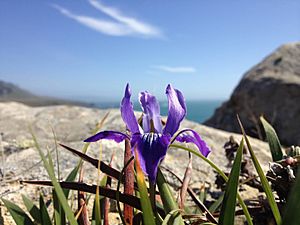
Fort Ross usually has cool, damp weather for most of the year. Fog and low clouds are common all year. Sometimes there are warm days in the summer. These days are usually dry, except for light rain from heavy fogs or quick showers.
The average temperature in January is between 57.0 °F (13.9 °C) and 41.5 °F (5.3 °C). In July, it ranges from 66.3 °F (19.1 °C) to 47.8 °F (8.8 °C). September is actually the warmest month. Temperatures then range from 68.1 °F (20.1 °C) to 48.7 °F (9.3 °C).
There are very few days with highs of 90 °F (32 °C) or higher (about 0.2 days). There are also few days with lows of 32 °F (0 °C) or lower (about 5.8 days). The highest temperature ever recorded was 97 °F (36 °C) on September 3, 1950. The lowest was 20 °F (−7 °C) on December 8, 1972.
Fort Ross gets about 37.64 inches (956 mm) of rain each year. It rains on about 81 days a year. The wettest year was 1983, with 71.27 inches (1.810 m) of rain. The driest year was 1976, with 17.98 inches (457 mm). The most rain in one month was 21.68 inches (551 mm) in February 1998. The most rain in 24 hours was 5.70 inches (145 mm) on January 14, 1956. Snow rarely falls at Fort Ross. The most snow ever recorded was 0.4 inches (10 mm) on December 30, 1987.
| Climate data for Fort Ross | |||||||||||||
|---|---|---|---|---|---|---|---|---|---|---|---|---|---|
| Month | Jan | Feb | Mar | Apr | May | Jun | Jul | Aug | Sep | Oct | Nov | Dec | Year |
| Record high °F (°C) | 83 (28) |
79 (26) |
78 (26) |
86 (30) |
94 (34) |
88 (31) |
88 (31) |
87 (31) |
97 (36) |
97 (36) |
80 (27) |
76 (24) |
97 (36) |
| Mean daily maximum °F (°C) | 56.8 (13.8) |
58.3 (14.6) |
59.2 (15.1) |
60.9 (16.1) |
62.9 (17.2) |
65.7 (18.7) |
66.5 (19.2) |
67.1 (19.5) |
68 (20) |
66.1 (18.9) |
61.5 (16.4) |
57.5 (14.2) |
62.6 (17.0) |
| Mean daily minimum °F (°C) | 41.7 (5.4) |
42.4 (5.8) |
42.3 (5.7) |
42.6 (5.9) |
44.6 (7.0) |
47 (8) |
48 (9) |
48.9 (9.4) |
49 (9) |
47.3 (8.5) |
44.6 (7.0) |
41.7 (5.4) |
45 (7) |
| Record low °F (°C) | 22 (−6) |
25 (−4) |
26 (−3) |
26 (−3) |
30 (−1) |
34 (1) |
35 (2) |
30 (−1) |
34 (1) |
30 (−1) |
27 (−3) |
20 (−7) |
20 (−7) |
| Average precipitation inches (mm) | 8.48 (215) |
6.81 (173) |
5.38 (137) |
2.72 (69) |
1.39 (35) |
0.58 (15) |
0.08 (2.0) |
0.15 (3.8) |
0.63 (16) |
2.39 (61) |
5.17 (131) |
6.83 (173) |
40.62 (1,032) |
| Average snowfall inches (cm) | 0 (0) |
0 (0) |
0 (0) |
0 (0) |
0 (0) |
0 (0) |
0 (0) |
0 (0) |
0 (0) |
0 (0) |
0 (0) |
0 (0) |
0 (0) |
| Average precipitation days | 13 | 12 | 11 | 7 | 4 | 2 | 1 | 1 | 2 | 5 | 9 | 12 | 79 |
Images for kids
-
A purple variety of the Douglas iris is a common sight in the area surrounding Fort Ross.
See also
 In Spanish: Fort Ross (California) para niños
In Spanish: Fort Ross (California) para niños





